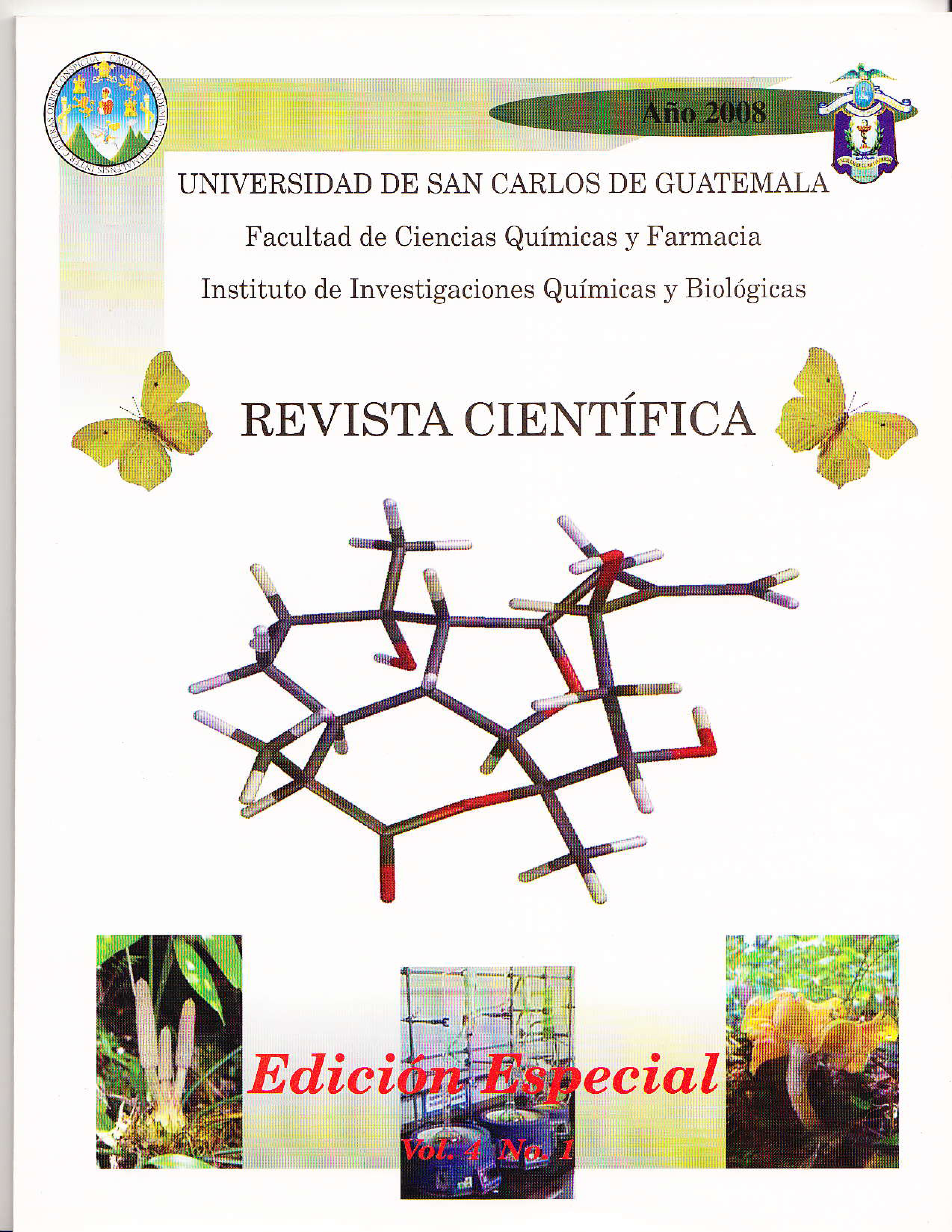Chemical Characterization of Essential Oils and Extracts of Mesoamerican Species of the Genus Piper as New Aromatic Resources
DOI:
https://doi.org/10.54495/Rev.Cientifica.EdicionEspecial2008.186%20Keywords:
Chemical characterization, Essential oils, Genus Piper, New aromatic resourcesAbstract
The Piperaceae family comprises 14 genera and approximately 700 species, which are distributed in tropical and subtropical zones of the world. In Guatemala, approximately 88 species of Piper are described, distributed in different regions of the country, of which very little chemical and pharmacological information is found. The present study contributes to the chemical study of the most important aromatic species of the genus Piper in Guatemala. 16 species were identified in 3 departments of Guatemala; in Suchitepéquez, 4 species were found (Piper umbellatum, P. oradendrnm, P. patulum and P. jaequemontianum); In Alta Verapaz, 8 species were found (P. geniculatum, R. jaequemontianum, P. obliquom, P. variabile, P. phytolaccifoiium, P. shippianum, P. sempervirens and P. hispidum) and in Izabal 4 species (P. peltatum, P. donnell smithii, P. fallens and R. diandrum). The essential oil of each species was obtained by hydrodistillation and its yield was calculated. The chemical characterization of the extracts was carried out by macro and semimicro tests and thin layer chromatography, determining the presence of alkaloids, flavonoids, anthraquinones, saponins, bitter principles, volatile oils and camarinas. The constituents of essential oils were identified by GC-MS, it was observed that R phytolaccifoiium was the species that presented the highest number of constituents (42), among which the majority was identified germacrano D 18%: P.umbellatum (39), presented as majority E'-nerolidol 23.4% and P. variabile (36), which presented as majority camphor 28.4%, and P. jaequemontianum which presented linalool 69.4% as majority. an interesting constituent in the perfume industry.
Downloads
References
Parmar, V.S. et al. 1997. Phytochemisry of the genus Piper, Phytochem. 46:597-673, https://doi.org/10.1016/S0031-9422(97)00328-2
Martins, AP. et al. 1998, Essential oils from four Piper species. Phytochem. 49:2019-2023, https://doi.org/10.1016/S0031-9422(98)00391-4
Moreira. D.L et al. 1998. Essential oil analysis of two Piper species (Piperaceae). An. Acad. Bras. Ci. 70:751-754, https://doi.org/10.17660/ActaHortic.1999.500.7
Vasques da Silva et al., 2002. Antifungal amides from Piper arboreum and Piper tuberculatum. Phytochem. 59:521-527, https://doi.org/10.1016/S0031-9422(01)00431-9
Dyer, L.A. et al. 2004. Isolation, synthesis, and evolutionary ecology of Piper amides. In: Dyer, L.A., Palmer. A.D.N. - Piper. A model genus for studies of phytochemistry, ecology, and evolution.-New York. Kluwer Academic/Plenum Publishers, pp. 117-139, https://doi.org/10.1007/978-0-387-30599-8_7
Cleaves, C. 2001. Etnobotánica participativa en siete comunidades de la zona de influencia del Parque Nacional Laguna Lachúa, Coban, Alta Verapaz. Guatemala. 282 p. Tesis Escuela de Biología, Guatemala, USAC.
Standley PC, Steyermark JA (1952) Flora of Guatemala. Fieldiana: Botany 24(3):275.
Stevens, WD. et al., (2001). Flora de Nicaragua. USA. Missouri Botanical Garden Press. (3), 2510.
European Pharmacopoeia 2002. Strasbourg, Conseil de L’Europe
Solis P et al. 2005. Manual de caracterización y análisis de drogas vegetales y productos fitoterapeuticos. Guatemala, Proyecto AICD/AE-089, 132p.
Lock de Ugaz,. O. 1994. Investigación fitoquímica. 2a edición. Pontificia Universidad Católica del Perú, Lima.
Wagner H, Bladt S. 1996. Plant Drug Analysis. Berlin. Springer Verlag, https://doi.org/10.1007/978-3-642-00574-9
Mundina, M. et al. (1998). Leaf essential oils of three Panamanian Piper species. Phytochem. 47: 1277-1 282, https://doi.org/10.1016/S0031-9422(97)00762-0
Dias dos Santos, P. et al. (2001 ) Essential oil analysis of 10 Piperaceae species from the Brazilian Atlantic forest. Phytochem. 58:547-551, https://doi.org/10.1016/S0031-9422(01)00290-4
Downloads
Published
How to Cite
Issue
Section
License
Copyright (c) 2008 S. Cruz, R. Veliz, A. Gómez, L. Álvarez, A. Cáceres, J. Morales, M. Apel, A. Henriquez

This work is licensed under a Creative Commons Attribution 4.0 International License.
Authors who publish with this journal agree to the following terms:
- Authors retain copyright and grant the journal right of first publication with the work simultaneously licensed under a Creative Commons Attribution License 4.0 that allows others to share the work with an acknowledgement of the work's authorship and initial publication in this journal.
- Authors are able to enter into separate, additional contractual arrangements for the non-exclusive distribution of the journal's published version of the work (e.g., post it to an institutional repository or publish it in a book), with an acknowledgement of its initial publication in this journal.
- Authors are permitted and encouraged to post their work online (e.g., in institutional repositories or on their website) prior to and during the submission process, as it can lead to productive exchanges, as well as earlier and greater citation of published work.









